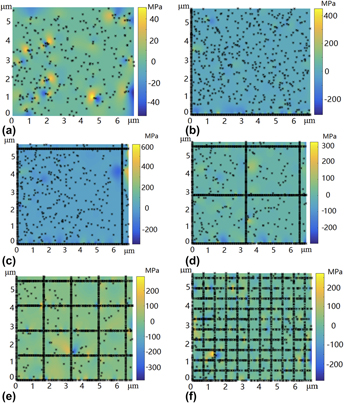Crossref Citations
This article has been cited by the following publications. This list is generated based on data provided by
Crossref.
Bai, Jinxuan
Bai, Qingshun
and
Tong, Zhen
2017.
Multiscale Analyses of Surface Failure Mechanism of Single-Crystal Silicon during Micro-Milling Process.
Materials,
Vol. 10,
Issue. 12,
p.
1424.
Bai, Jinxuan
Bai, Qingshun
and
Tong, Zhen
2017.
Dislocation Dynamics-Based Modeling and Simulations of Subsurface Damages Microstructure of Orthogonal Cutting of Titanium Alloy.
Micromachines,
Vol. 8,
Issue. 10,
p.
309.
Bai, Jinxuan
Bai, Qingshun
and
Tong, Zhen
2018.
Experimental and multiscale numerical investigation of wear mechanism and cutting performance of polycrystalline diamond tools in micro-end milling of titanium alloy Ti-6Al-4V.
International Journal of Refractory Metals and Hard Materials,
Vol. 74,
Issue. ,
p.
40.
Bai, Qingshun
Bai, Jinxuan
Hu, Chao
and
Guo, Hui
2018.
Investigation on the dislocation evolution in nanoindentation with 2.5D discrete dislocation dynamics simulation and experiment.
Materials Science and Engineering: A,
Vol. 730,
Issue. ,
p.
84.
Bai, Jinxuan
Bai, Qingshun
Tong, Zhen
and
Chen, Guoda
2018.
The influence of cutting parameters on the defect structure of subsurface in orthogonal cutting of titanium alloy.
Journal of Materials Research,
Vol. 33,
Issue. 6,
p.
720.
Bai, Jinxuan
Bai, Qingshun
Tong, Zhen
and
Guo, Hui
2018.
Theoretical model for subsurface microstructure prediction in micro-machining Ti-6Al-4V alloy – Experimental validation.
International Journal of Mechanical Sciences,
Vol. 148,
Issue. ,
p.
64.
Jiang, Bin
Xu, Xingliang
Zhao, Peiyi
Fan, Lili
and
Gu, Yunpeng
2020.
Multi-scale method for recognizing damage in high-efficiency milling cutter.
The International Journal of Advanced Manufacturing Technology,
Vol. 107,
Issue. 5-6,
p.
2547.
Dong, Huicong
Feng, Zhihao
Liang, Shunxing
Sun, Xinyang
Li, Jianhui
Wu, Dayong
Su, Ru
and
Zhang, Xinyu
2020.
Evolution of microstructure, mechanical properties and corrosion behaviors using cooling rate regulation in a novel ZrTi-based alloy.
Journal of Materials Research and Technology,
Vol. 9,
Issue. 3,
p.
3471.
Zhang, Yabo
Bai, Qingshun
Bai, Jinxuan
Guo, Hui
and
Cheng, Kai
2021.
Dislocation evolution in nanoscratching the CVD diamond film: Discrete dislocation dynamics simulation and experiments.
MRS Communications,
Vol. 11,
Issue. 5,
p.
619.
Bai, Jinxuan
and
Tong, Zhen
2021.
A novel multiscale material plasticity simulation model for high-performance cutting AISI 4140 steel.
The International Journal of Advanced Manufacturing Technology,
Vol. 116,
Issue. 11-12,
p.
3891.
Xie, Baobin
Fang, Qihong
and
Li, Jia
2022.
Investigation of nanomachining-induced plastic behavior using machine learning-assisted high-throughput molecular dynamics simulations.
The International Journal of Advanced Manufacturing Technology,
Vol. 119,
Issue. 11-12,
p.
8057.
Fan, Yihang
Wang, Bing
Hao, Zhaopeng
and
Cui, Gangwei
2023.
A GND simulation model for micro-deformation mechanism analyses in high-speed cutting Inconel718.
The International Journal of Advanced Manufacturing Technology,
Vol. 128,
Issue. 7-8,
p.
2931.
Wang, Sujuan
Zhao, Shuai
Xu, Ronghuan
Huang, Leyang
and
Sun, Zhanwen
2025.
An investigation on subsurface generation in ultra-precision milling of nickel with multiscale crystal plasticity FE model.
Journal of Manufacturing Processes,
Vol. 141,
Issue. ,
p.
815.




